Photo Attribution: Emerald, Muzo Mine, Vasquez-Yacopí Mining District, Boyacá Department
File:Béryl var. émeraude sur gangue (Muzo Mine Boyaca – Colombie) 2.jpg. (2018, August 10). Wikimedia Commons, the free media repository. Retrieved 17:51, February 11, 2019 from
https://commons.wikimedia.org/w/index.php?title=File:B%C3%A9ryl_var._%C3%A9meraude_sur_gangue_(Muzo_Mine_Boyaca_-_Colombie)_2.jpg&oldid=314327347.
Module 2: Using the Petrographic Microscope
2.3 Light and Optics Part 1: Electromagnetic Spectrum, Properties of Light
Elizabeth A. Johnson; Juhong Christie Liu; and Mark Peale
Introduction
You may be well aware of the importance of visible light for making observations in the geosciences. For example, the color of minerals and rocks can help us identify them (although it is not always the best identifier!). Color is determined by the relative absorbance or reflection of different wavelengths of visible light.
For example, a gem-quality emerald is a deep green color. This is because it is reflecting the green wavelengths of light to our eyes, and is absorbing the other visible wavelengths of light. Emerald is the mineral beryl, but it is trace Cr3+ in the mineral structure that causes the green color.
Visible light represents a small range of the electromagnetic spectrum. Even though no human can see beyond the visible range, we can still use technology to “see” the electromagnetic spectrum beyond anyone’s reach.
The electromagnetic energy we cannot see (but can detect with instrumentation) can be used to study the chemical composition of materials, can detect the vibrations of molecules and minerals, and can see the structure of solid materials, among other things.
This chapter provides a practical basis for applying knowledge of electromagnetic energy to optical microscopy.
Learning Objectives
Learning Objectives
Students should be able to:
- Describe the categories of electromagnetic energy within the electromagnetic spectrum, and be able to place these categories relative to each other in wavelength and energy.
- Describe the wavelengths of visible light and name a color for a given wavelength range.
- Describe the ways in which electromagnetic energy can behave when it interacts with an object.
- Define characteristics of light, including the speed of light, wave front, and light ray.
- Define refractive index.
- Differentiate between the electric and magnetic components of light.
- Use the electric (E) vector of light to describe the behavior of plane polarized light.
Prior Knowledge and Skills
None
The Electromagnetic Spectrum
The video below gives an overview of the electromagnetic spectrum:
The number of crests that pass a given point within one second is described as the frequency of the wave. One wave—or cycle—per second is called a Hertz (Hz), after Heinrich Hertz who established the existence of radio waves. A wave with two cycles that pass a point in one second (as shown for the top wave in Figure 2.3.2) has a frequency of 2 Hz.
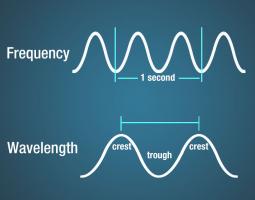
Electromagnetic waves have crests and troughs similar to (but not identical in behavior to) those of ocean waves. The distance between crests is the wavelength.
The figure below shows the wavelength (meters) and energy (Hz) ranges for different types of electromagnetic energy:
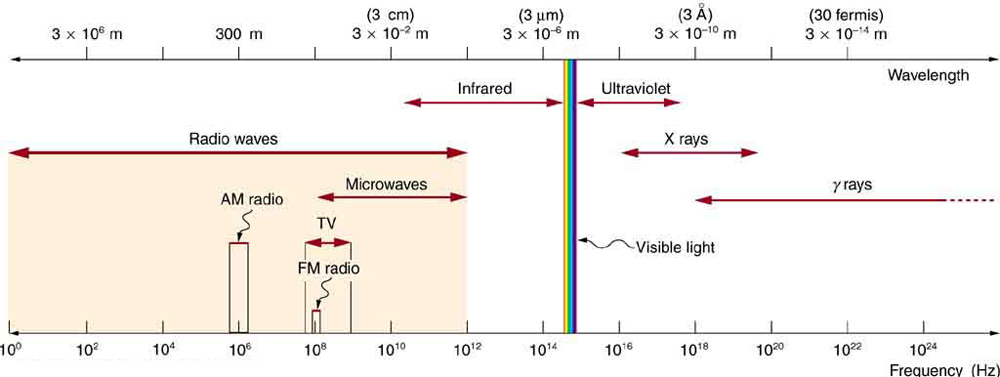
After watching the video and examining the figure above, answer these questions:
Guided Inquiry
Visible Light

The visible light region is divided into color regions (Figure 2.3.4). We will use colors (and color changes due to different microscopy techniques) to help identify minerals under thin section.
Guided Inquiry
Behavior of Light
Light waves across the electromagnetic spectrum behave in similar ways. When a light wave encounters an object, it is either transmitted, reflected, absorbed, refracted, polarized, diffracted, or scattered depending on the composition of the object and the wavelength of the light.
Absorption, Transmission, and Reflection
This video reviews the concepts of absorption, transmission, and reflection of light:
Diffraction, Scattering, and Refraction
Diffraction is the bending and spreading of waves around an obstacle. It is most pronounced when a light wave strikes an object with a size comparable to its own wavelength. In the case of visible light, the separation of wavelengths through diffraction results in a rainbow. The figure below shows the grooves on a CD diffracting visible light and producing iridescent colors.

Scattering occurs when light bounces off an object in a variety of directions. The amount of scattering that takes place depends on the wavelength of the light and the size and structure of the object.
The sky appears blue because of this scattering behavior. Light at shorter wavelengths—blue and violet—is scattered by nitrogen and oxygen as it passes through the atmosphere. Longer wavelengths of light—red and yellow—transmit through the atmosphere. This scattering of light at shorter wavelengths illuminates the skies with light from the blue and violet end of the visible spectrum. Even though violet is scattered more than blue, the sky looks blue to us because our eyes are more sensitive to blue light.
Refraction is when light waves change direction as they pass from one medium to another. Light travels slower in air than in a vacuum, and even slower in water. As light travels into a different medium, the change in speed bends the light. Different wavelengths of light are slowed at different rates, which causes them to bend at different angles. For example, when the full spectrum of visible light travels through the glass of a prism, or through a raindrop, the wavelengths are separated into the colors of the rainbow.
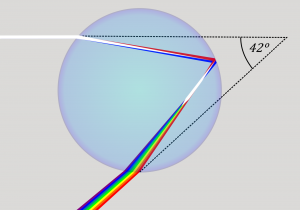
We will discuss refraction in more detail and introduce polarization of light in the sections below. These concepts are especially important for understanding techniques in optical mineralogy and petrology.
Guided Inquiry
Properties of Light
The speed of light (electromagnetic energy) in a vacuum is a constant value: c = 3.00 x 108 m/s. However, we will see below that electromagnetic energy slows down when it travels through matter, including minerals.
Knowing the propagation direction or direction of travel is important if we wish to understand how light moves through the microscope and our samples. The diagram below shows three views of an electromagnetic wave. In each view , a light ray pointing parallel to the direction of propagation and the wavefront perpendicular to the propagation direction are shown.
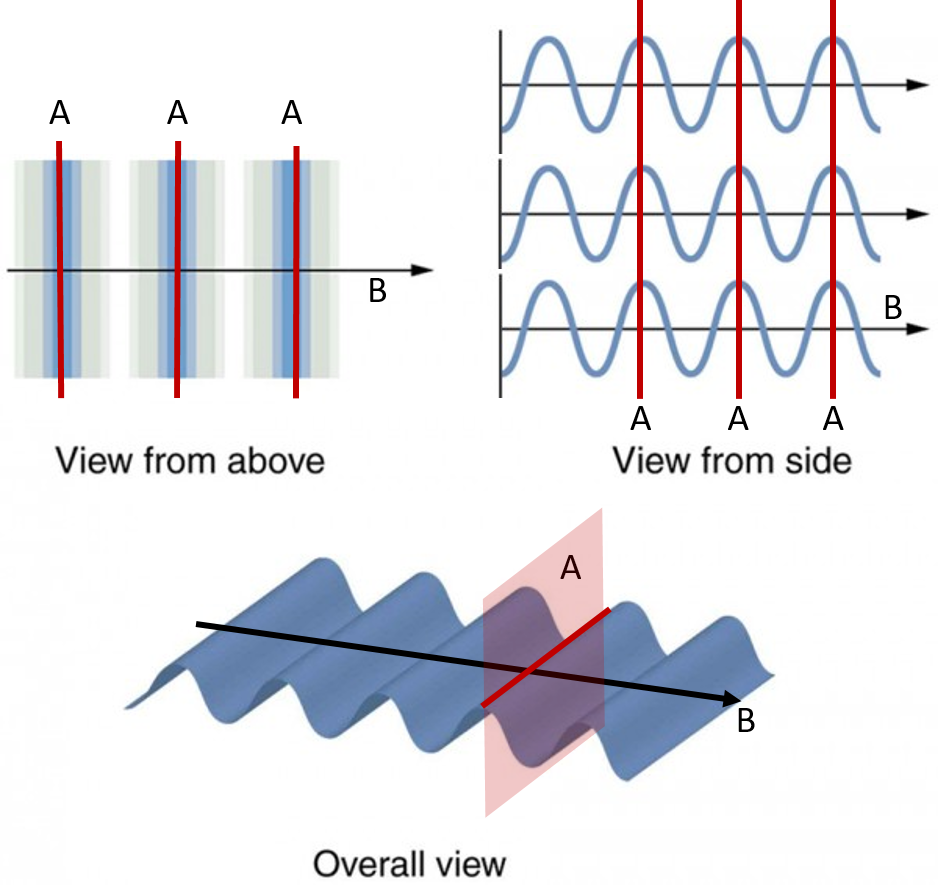
Guided Inquiry
Electromagnetic waves contain both electric and magnetic fields that change or oscillate. The electric field vector E is always perpendicular to the magnetic field vector B. Both E and B are perpendicular to the propagation direction of the wave. We will learn more about the electric field vector E in the section on polarization of light.
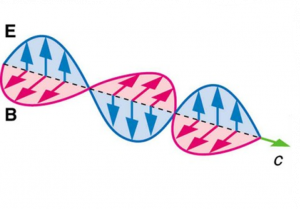
Key Terms
- Wavelength
- Frequency
- Visible, Infrared, Ultraviolet light
- Transmission
- Reflection
- Absorption
- Diffraction
- Scattering
- Refraction
- Polarization
- Speed of Light
- Wave front
- Ray
- Electric field vector
- Magnetic field vector
References
Bozeman Science (Jun 11, 2015) Light Absorption, Reflection, and Transmission. https://youtu.be/DOsro2kGjGc
Lumen Learning. Physics. CC-BY. https://courses.lumenlearning.com/physics/
National Aeronautics and Space Administration, Science Mission Directorate. (2010). Anatomy of an Electromagnetic Wave. Retrieved March 9, 2019, from NASA Science website: http://science.nasa.gov/ems/02_anatomy
National Aeronautics and Space Administration, Science Mission Directorate. (2010). Introduction to the Electromagnetic Spectrum. Retrieved March 9, 2019, from NASA Science website: http://science.nasa.gov/ems/01_intro
National Aeronautics and Space Administration, Science Mission Directorate. (2010). Wave Behaviors. Retrieved March 9, 2019 from NASA Science website: http://science.nasa.gov/ems/03_behaviors
OpenStax, College Physics. Creative Commons Attribution License v4.0. https://openstax.org/details/books/college-physics.
OpenStax, University Physics Volume 3. Creative Commons Attribution License 4.0 license. https://openstax.org/books/university-physics-volume-3/pages/1-1-the-propagation-of-light
PhET Interactive Simulations, University of Colorado Boulder. Bending Light. CC_BY. https://phet.colorado.edu/en/simulation/bending-light
Attributions
Media Attributions
- Figure 2.3.2 Wavelength and Frequency © National Aeronautics and Space Administration, Science Mission Directorate. (2010). Anatomy of an Electromagnetic Wave. is licensed under a Public Domain license
- 2_3_2 EM Spectrum from College Physics © OpenStax, College Physics. OpenStax CNX. Mar 4, 2019 is licensed under a CC BY (Attribution) license
- 2_3_3 Visible light spectrum from College Physics © OpenStax, College Physics. OpenStax CNX. is licensed under a CC BY-SA (Attribution ShareAlike) license
- Figure 2.3.5. A CD diffracting light © Luis Fernández García is licensed under a CC BY-SA (Attribution ShareAlike) license
- Figure 2.3.6. © KES47 is licensed under a Public Domain license
- Figure 2.3.7. Light waves © Open Stax University Physics Volume 3 adapted by Lumen Learning Physics II is licensed under a CC BY (Attribution) license
- Figure 2.3.8. E and B © Open Stax College Physics adapted by Lumen Learning Physics II is licensed under a CC BY (Attribution) license


